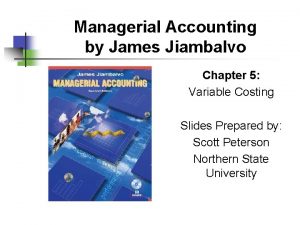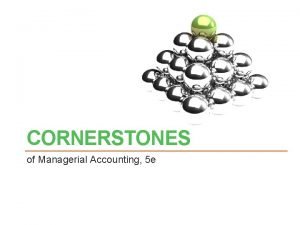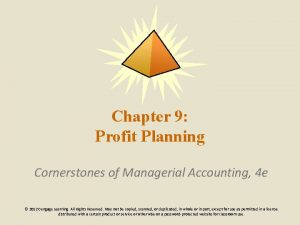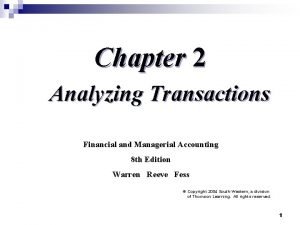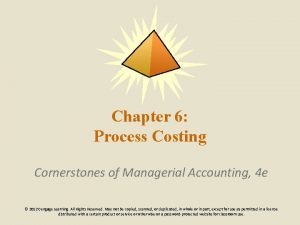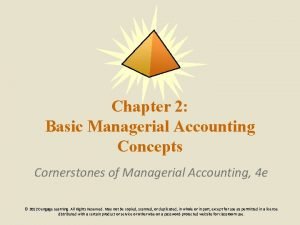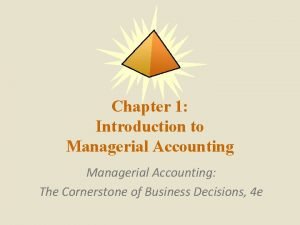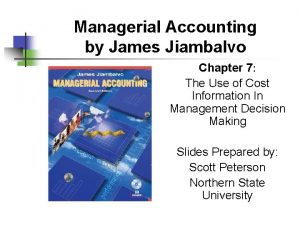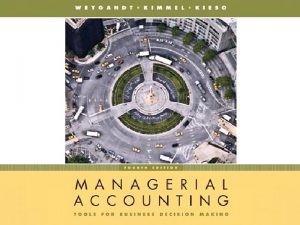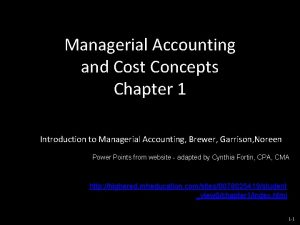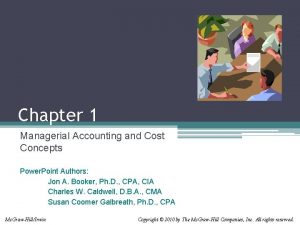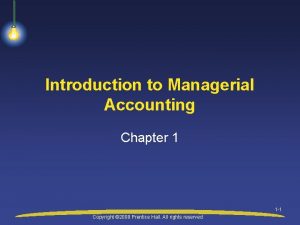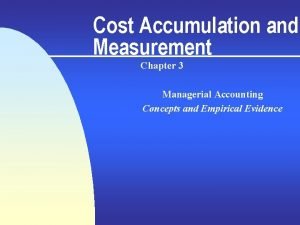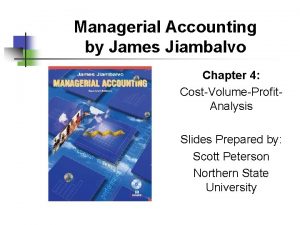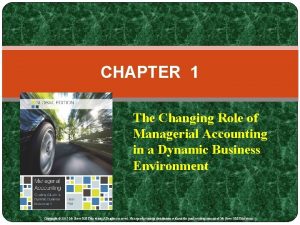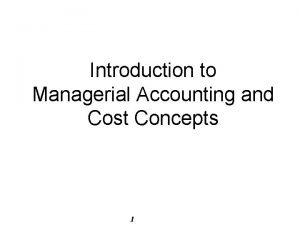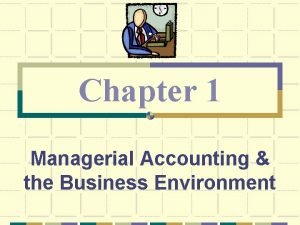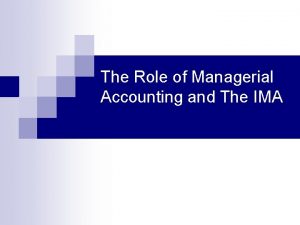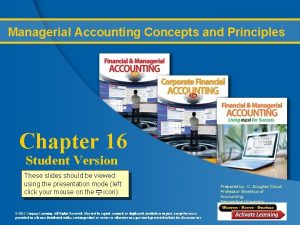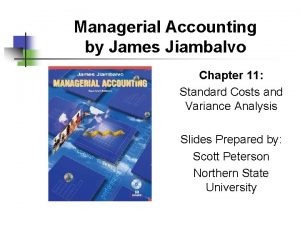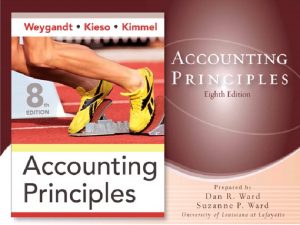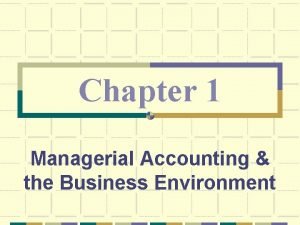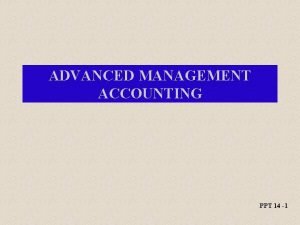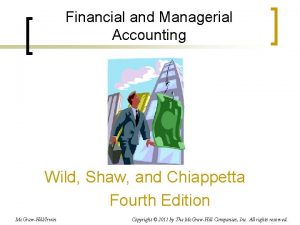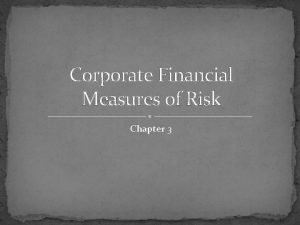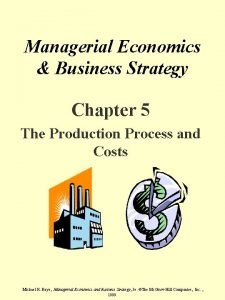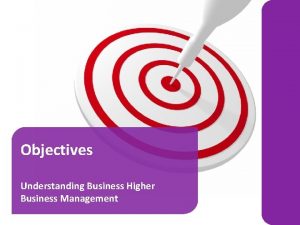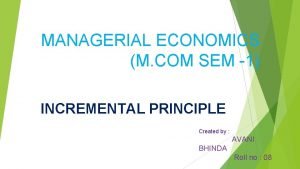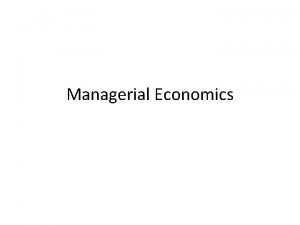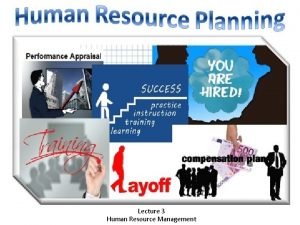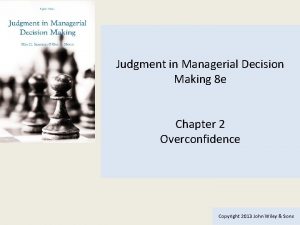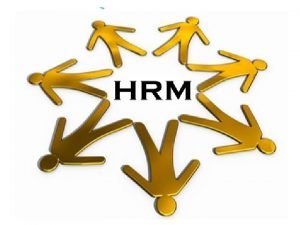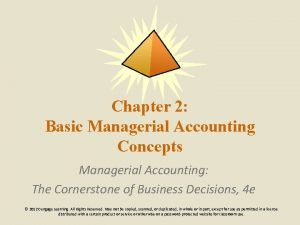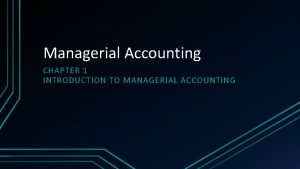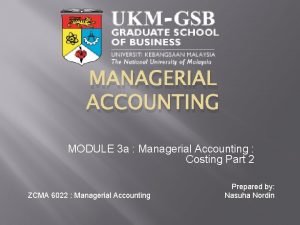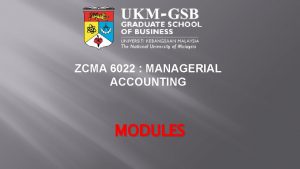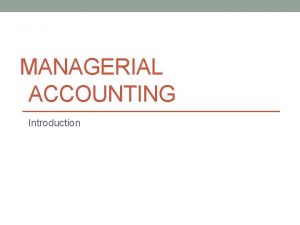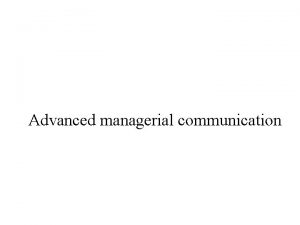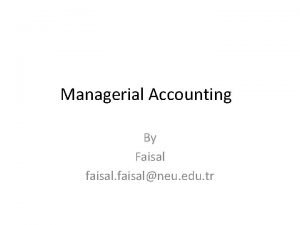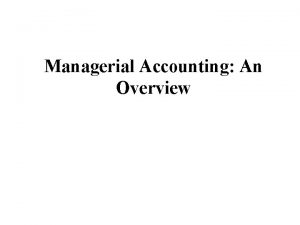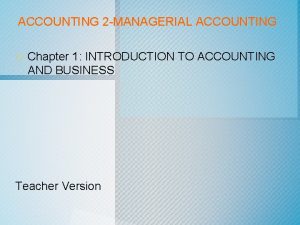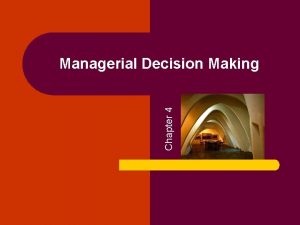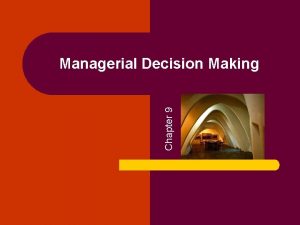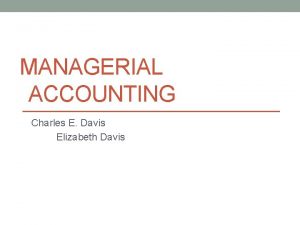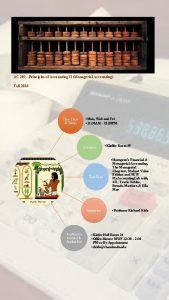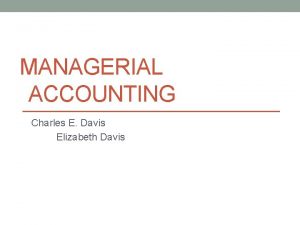Chapter 19 1 CHAPTER 19 MANAGERIAL ACCOUNTING Accounting















































- Slides: 47

Chapter 19 -1

CHAPTER 19 MANAGERIAL ACCOUNTING Accounting Principles, Eighth Edition Chapter 19 -2

Study Objectives 1. Explain the distinguishing features of managerial accounting. 2. Identify the 3 broad functions of management. 3. Define the 3 classes of manufacturing costs. 4. Distinguish between product and period costs. 5. Explain the differences between a merchandising and a manufacturing income statement. Chapter 19 -3

Study Objectives 6. Indicate how cost of goods manufactured is determined. 7. Explain the difference between a merchandising and a manufacturing balance sheet. 8. Identify trends in managerial accounting. Chapter 19 -4

Preview of Chapter Managerial Accounting Basics Compare managerial and financial accounting Management functions and Business Ethics Managerial Cost Concepts Manufacturing costs Product vs. period costs Manufacturing Costs in Financial Statements Income Statement and Balance Sheet Cost concepts – A review Managerial Accounting Today Service industry trends Chapter 19 -5 Managerial accounting practices

Managerial Accounting Basics Compare Managerial and Financial Accounting Management Functions Business Ethics Chapter 19 -6 Managerial Cost Concepts Manufacturing Costs Product vs Period Costs Manufacturing Costs in Financial Statements Income Statement Balance Sheet Cost Concepts – A Review Managerial Accounting Today Service Industry Trends Managerial Accounting Practices

Managerial Accounting Basics Definition of Managerial Accounting A field of accounting that provides economic and financial information for managers and other internal users. Also called Management Accounting Chapter 19 -7

Managerial Accounting Basics Managerial Accounting Activities Explain manufacturing and nonmanufacturing costs and how they are reported (Chapter 19) Compute cost of providing a service or manufacturing a product. (Chapters 20 and 21) Determine behavior of costs and expenses as activity changes. (Chapter 22) Chapter 19 -8

Managerial Accounting Basics Managerial Activities: Continued Assist management in profit planning and formalizing these plans in the form of budgets. (Chapter 23) Help to control costs by comparing actual results with planned objectives and standard costs. (Chapters 24 and 25) Accumulate and present data for making decisions. (Chapter 26) Chapter 19 -9

Managerial Accounting Basics Distinguishing Features Applies to all types of business Service, Merchandising, and Manufacturing Applies to all forms of businesses – Proprietorships, Partnerships, and Corporations Applies to not-for-profit and profit oriented companies Chapter 19 -10 LO 1 Explain the distinguishing features of managerial accounting.

Managerial Accounting Basics Distinguishing Features: Continued More responsible for strategic cost management Teams with people from production, marketing, engineering, etc. Aid in making critical decisions Chapter 19 -11 LO 1 Explain the distinguishing features of managerial accounting.

Comparing Managerial and Financial Accounting Similarities Both deal with economic events of a business – Thus, interests overlap Both require that economic events be quantified and communicated to interested parties – Determining unit cost is part of managerial accounting, Reporting cost of goods manufactured is a part of financial accounting Chapter 19 -12 LO 1 Explain the distinguishing features of managerial accounting.

Comparing Managerial and Financial Accounting Differences Chapter 19 -13 LO 1 Explain the distinguishing features of managerial accounting.

Managerial Accounting Basics Review Question Managerial accounting: a. Pertains to the entity as a whole and is highly aggregated b. Places emphasis on special-purpose information. c. Is limited to cost data. d. Is governed by generally accepted accounting principles. Chapter 19 -14 LO 1 Explain the distinguishing features of managerial accounting.

Managerial Accounting Basics Management Functions Management’s activities and responsibilities can be classified into the following three broad functions: Planning Chapter 19 -15 Directing Controlling LO 2 Identify the 3 broad functions of management.

Management Functions Planning Look ahead and establish objectives such as – Maximize short-term profit Commit to environmental protection Key Objective: Add value to the business Value measured by trading price of stock and by potential selling price of the company Chapter 19 -16 LO 2 Identify the 3 broad functions of management.

Management Functions Directing Coordinate diverse activities and human resources Implement planned objectives Provide incentives to motivate employees Hire and train employees including executives, managers, and supervisors Produce smooth-running operation Chapter 19 -17 LO 2 Identify the 3 broad functions of management.

Management Functions Controlling Keep activities on track Determine whether goals are met Decide changes needed to get back on track May use an informal or formal system of evaluations Good decision making is the outcome of good judgment in planning, directing, and controlling. Chapter 19 -18 LO 2 Identify the 3 broad functions of management.

Good Ethics – Good Business Ethics Business scandals caused massive investment losses and employee layoffs. Corporate fraud has increased 13% in last 5 years. Employee fraud – 60% of all fraud Intentional misstatement of financial reports Aka financial reporting fraud Most costly to companies Chapter 19 -19

Good Ethics – Good Business Creating Proper Incentives Systems to monitor and evaluate employees may produce incentives for unethical actions. Employees may feel that they must succeed no matter what. Ineffective and unrealistic controls may result in declining product quality. Chapter 19 -20

Good Ethics – Good Business Code of Ethical Standards Sarbanes-Oxley Act of 2002 Clarifies management’s responsibilities. Certifications by CEO and CFO fairness of financial statements and adequacy of internal control Selection criteria for Board of Directors and Audit Committee Substantially increased penalties for misconduct IMA Statement of Ethical Professional Practices Chapter 19 -21

Management Functions Review Question The management of an organization performs several broad functions. They are: a. Planning, directing, and selling b. Directing, manufacturing, and controlling. c. Planning, manufacturing, and controlling. d. Planning, directing, and controlling. Chapter 19 -22 LO 2 Identify the 3 broad functions of management.

Managerial Cost Concepts Manufacturing Costs Manufacturing consists of activities to convert raw materials into finished goods. In contrast, a merchandising firm sells goods in the form in which they were bought. Categories of manufacturing costs include: Chapter 19 -23 LO 3 – Define three classes of manufacturing costs.

Manufacturing Costs Materials Raw Materials Basic materials used in manufacturing Direct Materials Raw materials that can be physically and directly associated with the finished product Chapter 19 -24 LO 3 Define three classes of manufacturing costs.

Manufacturing Costs Materials Indirect Materials Raw materials that cannot be easily associated with the finished product Not physically part of the finished product or they are an insignificant part of finished product in terms of cost Considered part of manufacturing overhead Chapter 19 -25 LO 3 Define three classes of manufacturing costs.

Manufacturing Costs Labor Direct Labor Work of factory employees that can be physically and directly associated with converting raw materials into finished goods Indirect Labor Work of factory employees that has no physical association with the finished product or for which it is impractical to trace to the goods produced Chapter 19 -26 LO 3 Define three classes of manufacturing costs.

Manufacturing Costs Manufacturing Overhead Costs that are indirectly associated with manufacturing the product Includes all manufacturing costs except direct materials and direct labor Chapter 19 -27 LO 3 Define three classes of manufacturing costs.

Manufacturing Costs Review Question Which of the following is not an element of manufacturing overhead? : a. Sales manager’s salary. b. Plant manager’s salary. c. Factory repairman’s wages. d. Product inspector’s salary. Chapter 19 -28 LO 3 Define three classes of manufacturing costs.

Product Versus Period Costs Product Costs Components: direct material cost, direct labor cost, and manufacturing overhead A necessary and integral part of producing the product Recorded as inventory when incurred Not an expense until the finished goods inventory is sold then cost of goods sold Chapter 19 -29 LO 4 Distinguish between product and period costs.

Product Versus Period Costs Matched with revenue of a specific time period and charged to expense as incurred Non-manufacturing costs Deducted from revenues in period incurred to determine net income Includes all selling and administrative expenses Chapter 19 -30 LO 4 Distinguish between product and period costs.

Product Versus Period Costs Chapter 19 -31 LO 4 Distinguish between product costs and period costs.

Manufacturing Costs in Financial Statements Income Statement The income statement for a manufacturer is similar to that of a merchandiser except for the cost of goods sold section. Chapter 19 -32 LO 5 Explain the difference between a merchandising and a manufacturing income statement.

Manufacturing Costs in Financial Statements Cost of Goods Sold Components Merchandiser versus Manufacturer Chapter 19 -33 LO 5 Explain the difference between a merchandising and a manufacturing income statement.

Manufacturing Costs in Financial Statements Cost of Goods Sold Section of the Income Statement Chapter 19 -34 LO 5 Explain the difference between a merchandising and a manufacturing income statement.

Manufacturing Costs in Financial Statements Determining the Cost of Goods Manufactured Work in Process – partially completed units of product Total Manufacturing Costs – sum of direct material costs, direct labor costs, and manufacturing overhead; all incurred in the current period Chapter 19 -35 LO 6 Indicate how cost of goods manufactured is determined.

Manufacturing Costs in Financial Statements Chapter 19 -36 LO 6 Indicate how cost of goods manufactured is determined.

Manufacturing Costs in Financial Statements Balance Sheet - Inventories Merchandising Company One category of inventory: Merchandise Inventory Chapter 19 -37 Manufacturing Company May have three inventories: Raw Materials Work in Process Finished Goods LO 7 Explain the difference between a merchandising and a manufacturing balance sheet.

Manufacturing Costs in Financial Statements Balance Sheet - Inventories Chapter 19 -38 LO 7 Explain the difference between a merchandising and a manufacturing balance sheet

Manufacturing Costs Review Question Direct Materials are a: Product Cost Period Cost a. Yes No b. Yes No No c. Yes No No Yes d. No Chapter 19 -39 Manufacturing Overhead

Managerial Accounting Today Service Industry Trends U. S. economy has shifted toward an emphasis on providing services rather than goods Over 50% of U. S. workers are now employed by service companies Trend is expected to continue in the future Most of the techniques learned for manufacturing firms are applicable to service companies Chapter 19 -40 LO 8 Identify trends in management accounting.

Managerial Accounting Today Managerial Accounting Practices Value Chain Refers to all activities associated with providing a product or service For a manufacturing firm these include the following: Chapter 19 -41 LO 8 Identify trends in management accounting.

Managerial Accounting Today Managerial Accounting Practices Just-In-Time (JIT) Inventory Methods Inventory system in which goods are manufactured or purchased just in time for use Quality Increased emphasis on product quality because goods are produced only as needed Total Quality Management (TQM) - a philosophy of zero defects Chapter 19 -42 LO 8 Identify trends in management accounting.

Managerial Accounting Today Managerial Accounting Practices Activity-Based-Costing (ABC) Allocates overhead based on use of activities chain Results in more accurate product costing and scrutiny of all activities in the value Balanced Scorecard Evaluates operations in an integrated fashion measures Uses both financial and non-financial Links performance measures to overall LO 8 Identify trends in management accounting. company objectives Chapter 19 -43

Managerial Accounting Today Review Question Which of the following managerial accounting techniques attempts to allocate manufacturing overhead in a more meaningful manner? a. Just-in-time inventory. b. Total-quality management. c. Balanced scorecard. d. Activity-based costing. Chapter 19 -44 LO 8 Identify trends in management accounting.

Chapter Review - Brief Exercise 19 -5 Indicate whether each of the following costs of an automobile manufacturer would be classified as direct materials, direct labor, or manufacturing overhead. ______ DM ______ DL ______ MO ______ DM ______ MO Chapter 19 -45 a. b. c. d. e. f. g. h. Windshield Engine Wages of assembly line worker Depreciation of factory machinery Factory machinery lubricants Tires Steering wheel Salary of painting supervisor

Chapter Review - Brief Exercise 19 -6 Identify whether each of the following costs should be classified as product costs or period costs. ______ Product ____________ Period ____________ Product Chapter 19 -46 a. b. c. d. e. f. Manufacturing overhead Selling expenses Administrative expenses Advertising expense Direct labor Direct material

Copyright © 2008 John Wiley & Sons, Inc. All rights reserved. Reproduction or translation of this work beyond that permitted in Section 117 of the 1976 United States Copyright Act without the express written permission of the copyright owner is unlawful. Request for further information should be addressed to the Permissions Department, John Wiley & Sons, Inc. The purchaser may make back-up copies for his/her own use only and not for distribution or resale. The Publisher assumes no responsibility for errors, omissions, or damages, caused by the use of these programs or from the use of the information contained herein. Chapter 19 -47
 Managerial accounting chapter 5 solutions
Managerial accounting chapter 5 solutions Managerial accounting chapter 13 solutions
Managerial accounting chapter 13 solutions Managerial accounting chapter 9
Managerial accounting chapter 9 Financial accounting chapter 2 solutions
Financial accounting chapter 2 solutions Managerial accounting chapter 6
Managerial accounting chapter 6 Conversion cost formula
Conversion cost formula Managerial accounting chapter 1
Managerial accounting chapter 1 Managerial accounting chapter 7
Managerial accounting chapter 7 Chapter 1 managerial accounting
Chapter 1 managerial accounting Relevant range managerial accounting
Relevant range managerial accounting Cost theory and estimation
Cost theory and estimation Chapter 1 managerial accounting and cost concepts
Chapter 1 managerial accounting and cost concepts Chapter 1 managerial accounting
Chapter 1 managerial accounting Managerial accounting chapter 3
Managerial accounting chapter 3 Management accounting scope
Management accounting scope Jiambalvo managerial accounting
Jiambalvo managerial accounting Role of managerial accounting
Role of managerial accounting Financial and managerial accounting weygandt kimmel kieso
Financial and managerial accounting weygandt kimmel kieso Managerial accounting and cost concepts
Managerial accounting and cost concepts Accounting and the business environment
Accounting and the business environment Managerial accounting
Managerial accounting Accounting principles and concepts
Accounting principles and concepts Managerial accounting james jiambalvo
Managerial accounting james jiambalvo Nature of managerial accounting
Nature of managerial accounting Manufacturing accounting basics
Manufacturing accounting basics Distinguishing features of managerial accounting
Distinguishing features of managerial accounting Managerial accounting and the business environment
Managerial accounting and the business environment Activity based costing ppt
Activity based costing ppt Wild financial and managerial accounting
Wild financial and managerial accounting Dol managerial accounting
Dol managerial accounting Financial accounting chapter 1
Financial accounting chapter 1 Ecomics
Ecomics What are the fundamental concepts of managerial economics
What are the fundamental concepts of managerial economics Managerial economics chapter 1
Managerial economics chapter 1 Conclusion for computerized accounting
Conclusion for computerized accounting Basic accountin
Basic accountin Accounting responsibility
Accounting responsibility Zero based forecasting
Zero based forecasting Managerial process of crafting and executing strategy
Managerial process of crafting and executing strategy Sport law a managerial approach
Sport law a managerial approach Business management objectives
Business management objectives Meaning of managerial economics in simple words
Meaning of managerial economics in simple words Incremental reasoning
Incremental reasoning Managerial economics:
Managerial economics: Demand forecasting and estimation
Demand forecasting and estimation Hr supply forecasting techniques
Hr supply forecasting techniques Judgment in managerial decision making 8th edition
Judgment in managerial decision making 8th edition Human resource management process
Human resource management process
